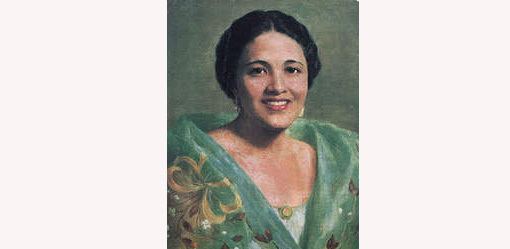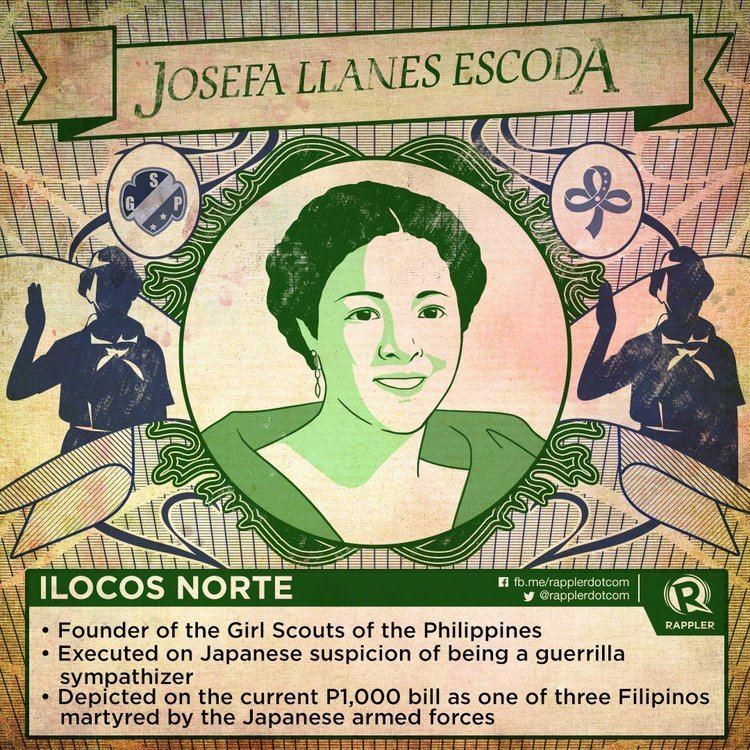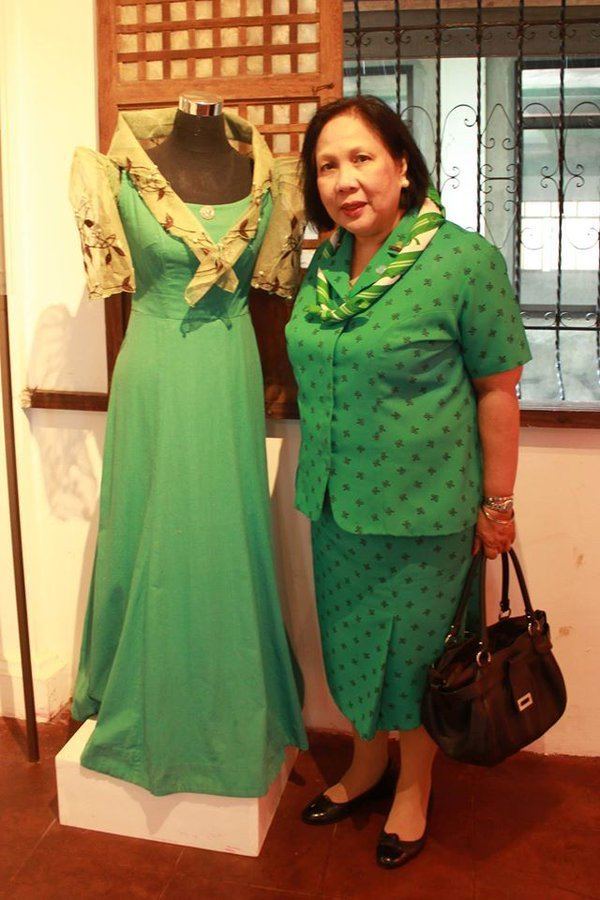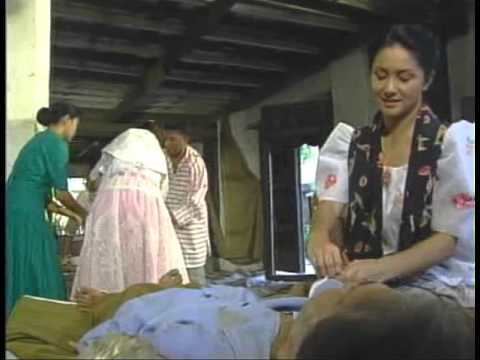Name Josefa Escoda | Spouse Antonio Escoda | |
 | ||
Full Name Josefa Madamba Llanes Born 20 September 1898 Dingras, Ilocos Norte, Captaincy General of the Philippines Resting place unmarked grave in La Loma Cemetery, Caloocan City, Philippines Parent(s) Mercedes Madamba and Gabriel Llanes Died January 6, 1945, Manila, Philippines Education University of the Philippines Organizations founded Girl Scouts of the Philippines Similar People Jose Abad Santos, Vicente Lim, Jose Calugas | ||
Josefa llanes escoda biography
Josefa Llanes Escoda (20 September 1898–c. 6 January 1945), also known as the "Florence Nightingale of the Philippines", is a war heroine, great civic leader, and social worker. She was a well-known Filipino advocate of women's right of suffrage and founder of the Girl Scouts of the Philippines.
Contents
- Josefa llanes escoda biography
- Bayani josefa llanes escoda
- Early life
- Girl Scouts of the Philippines
- World War II
- Legacy
- References

Bayani josefa llanes escoda
Early life

Josefa was born in [Dingrasa Ilocos Norte|Dingras]], Ilocos Norte as Josefa Llanes (y) Madamba. She was the eldest of the seven children of Mercedes Madamba and Gabriel Llanes. Josefa's siblings were, Florencio, Luisa, Elvira, Rosario, Purita and Eufrocina. Josefa (or Pepa, her nickname as a child) grew up with an instilled idea of the true Christian service. Her mother was said to be a sweet, loving woman who taught her children the importance of serving the people. This amiable character honed by her mother manifested in many parts of Pepa’s life.

During her elementary days, Pepa was known to be a sunny, naturally active and precocious student. She also had unyielding importance for education. Josefa was valedictorian in grade school and salutatorian in high school in Dingras Elementary School (Dingras, Ilocos Norte). She went to Philippine Normal School in Manila to earn her teaching degree, and graduated with honors in 1919. While working as a teacher, she earned a high school teacher's certificate from the University of the Philippines in 1922.

After obtaining her teacher's certificate, she became a social worker for the Philippine Chapter of the American Red Cross (the Philippines was a colony of the United States at the time). The Red Cross granted her a scholarship to the United States, where she earned a masteral degree in Sociology from Columbia University in 1925. While in the United States, Josefa joined a group of foreign students who wholeheartedly supported an International House project in New York. During her free time in the International House, she accepted speaking engagements. It was also her practice to wear a Filipiniana dress during her lecture tours to arouse foreigner’s interest in Philippines.

During her first trip to the United States, while she was at the Women's International League for Peace (1925), she met Antonio Escoda, a reporter from the Philippine Press Bureau whom she later married. They had two children: Maria Theresa (who later became President of the Cultural Center of the Philippines during Pres.Corazon Aquino's Administration); and Antonio, Jr.
Girl Scouts of the Philippines

She returned to the United States again in 1933 to undergo training in Girl Scouting sponsored by the Boy Scouts of the Philippines. Afterwards, she returned to the Philippines to train young women to become Girl Scout leaders, then proceeded to organize the Girl Scouts of the Philippines. On 26 May 1940, President Manuel L. Quezon signed the charter of the Girl Scouts of the Philippines. Josefa became the group's first National Executive.
World War II
During World War II, Japanese forces invaded the Philippines. By 1944, news of the underground activities of Josefa Llanes Escoda and her husband Antonio reached far and wide. As the Japanese Occupation stretched on, Josefa Llanes Escoda and Antonio had intensified their "smuggling" activities of sending medicines, clothings, messages, and food stuff to both Filipino war prisoners and American internees in concentration camps.
Lt. Jose L. Llanes, a courageous intelligence officer who was a commander of Ilocos Norte and Northern Ilocos Sur, said he saw Josefa Llanes Escoda on 14 January 1944 in the presence of her husband, Tony Escoda. Josefa Llanes Escoda left this last message to Lt. Jose L. Llanes:
"I have done my duty to my country and God! To my mind the most I have done is having helped with the little I could do to save the lives of the surrendered soldiers of Bataan and Corregidor. I have offered myself as a guarantor for men later released by the enemy, that they commit no anti-Japanese act, men who, if they had the guts left would continue their resistance. I have acted as guarantors not only for the sake of humanity but also to encourage them to fight again. If you happen to survive, and I fail, tell our people that the women of the Philippines did their part also in making the ember sparks of truth and liberty alive till the last moment."
Josefa Llanes Escoda's husband Antonio was arrested in June 1944, and Josefa Llanes Escoda was also arrested two months later on 27 August. She was incarcerated in Fort Santiago, sharing the same facility as her spouse, Antonio Escoda, who faced execution in 1944 alongside General Vicente Lim, a fellow detainee. On January 6, 1945, Josefa Llanes Escoda was subsequently transferred and detained in a structure within Far Eastern University that was under Japanese control. She was last seen alive on 6 January 1945, but severely beaten and weak, and was transferred into a Japanese transport truck. It is presumed that she was executed and buried in an unmarked grave, either in the La Loma Cemetery or Manila Chinese Cemetery, which Japanese forces used as execution and burial grounds for thousands of Filipinos who resisted the Japanese occupation.
Legacy
A street and a building have been named after her and a monument has been dedicated to her memory. She is also depicted on the current 1000-peso bill as one of three Filipinos martyred by the Japanese Armed Forces.
The Girl Scouts of the Philippines pays homage to Josefa Llanes Escoda every September 20 by celebrating her birth anniversary with activities that would create further awareness of her martyrdom and contribution to youth development.
